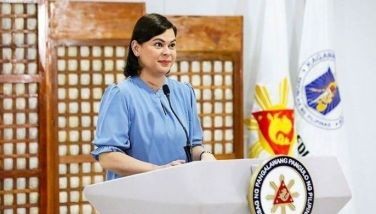In favor of return to ROTC program: Dev’t and discipline

One important institution of the nation that was discarded after the political changes that took place after the EDSA uprising of 1986 was the ROTC (Reserve Officer Training Corps) program as an integral part of university education.
President Duterte supports the restoration of ROTC training, arguing that the nation needs it and that it is every citizen’s important duty to support the state in case of need.
Countries that feel they are under siege by potential foreign enemies have much more stringent military preparedness training. They require conscription to military service of two years. An example is South Korea (see below).
ROTC training as practiced. From the very start of the program during the Commonwealth period, ours had been a very mild form of military training. It was a subsidiary of the nation’s national defense program within the school system.
At the collegiate level, it was designed to train young men who could opt or volunteer for a military career while pursuing their collegiate studies. The PMA (Philippine Military Academy), is an institution supported by the state to prepare officers for a military professional track.
The ROTC had a forced component whereby university male college entrants underwent introductory military training during the first two years of college. This consisted mainly of a few Saturday lectures (in my time as a university student, the 1950s) on military organization and discipline, and then a lot of field work – learning to march in formation for ordinary occasions and for the grand military parades and undertaking simulated military bivouacs.
The ROTC program had its high school counterpart: the PMT (I think it meant Preparatory Military Training) which was in the high school curriculum. This was mainly one of teaching the rudiments of military marching for the boys, like physical education.
A valuable element of university education. Important though it was as part of my university experience, ROTC was more a hindrance – like learning how to swim during the early 1950s.
What sticks most to memory were the marches under the hot sun during the dry months. Then, it was high discomfort under the sun and heat doing the march.
The rainy season brought an even more memorable occasion. Steady drizzle did not excuse us from marching, especially when preparing for the grand parade. Then we would trudge through the soft turf of the UP Sunken Garden behind the main library and turn it into mush. Such experience meant muddied khakis and shoes transformed into veritable cakes. It turned more heroic as military music from the accompanying ROTC band boomed with cinematic cadence.
It was a program which, at the end, we celebrated with good riddance, just like when we got our bachelor’s diplomas to say goodbye to our studies! Yet we remembered our company lieutenants and captains, our pretty company sponsors and the corps sponsors the way most of us remember our professors, friends, and our outstanding college activities.
My ROTC memory lane rings with names – platoon lieutenant, Aniano Desierto (later ombudsman); company captain, Peter Quijano; company sponsor, among the prettiest in the corps, Vicky Viterbo. During our time, too, there was the legendary corps sponsor of them all, Josie Trinidad!
Military training for the youth in other countries. Compared with other countries, the military training under the ROTC program was mild. To discard it was a mistake committed by the nation’s leaders in a moment of peeve.
Whether a country is at peace or war alert, the state has to be ready to meet contingencies with some element of defense preparedness.
In other countries where the nation felt much more threatened by external enemies, military training for the youth is more strict. Instead of ROTC training, there is the recourse to the military draft for all young people of age.
This conscription is sometimes confined to the male youth. In others, even women are included. Conscription into the military draft for two years is an aspect of their human development program.
South Korean example: discipline and industrial development. Sometime in 1982, I was invited by the Korean Development Institute (KDI) to deliver a talk before the group that composed their inaugural class in implementation of their International Development Exchange Program.
This was already one year after I had left NEDA as its founding director-general. I had been personally a student of South Korea’s economic development experience. Therefore, I happily accepted the invitation.
The program of the inaugural group included an intense tour of economic development projects throughout South Korea. To be immersed in these accomplishments, I decided to join the five-day tour through Ulsan, Masan, Chongwon, Taegu and Pusan, aside from project tours around Seoul. (I remember this from extensive notes I took then.)
The tour included visits to major infrastructure projects in agricultural and in urban development, major factories dealing with heavy industries, such as chemicals, steel, and shipbuilding, and electronics factories, including those owned by the Samsung Group and the Lucky Group.
We were regaled with seminars and plant visits; demonstrations and discussions with company officials. In the southern city of Pusan, the center of heavy industries in that country, the president of the Korea Chamber of Commerce and Industry, Mr. Chung Chang, gave a dinner, flying all the way from Seoul.
As I sat close to him, I asked him about the most important reasons for the Korean industrial success story.
Here was what he essentially told me. First was the threat of North Korea, so they had to do their best to succeed. Second was the training of human resources as provided by the army. For two years, young men were brought into the army until they were 21 years. This gave them a degree of discipline, group consciousness, and responsibility as they joined the workforce.
After this encounter, I followed up this tidbit of information by pummeling the young Korean guides who assisted our industrial and development project tours with follow-up questions. Their answers echoed this sentiment.
Many factors (including economic) account for the industrial success of South Korea. Military conscription was an inexpensive way to instill discipline and skills-training. It can also be added that it was also a source of entrepreneurial success in Korea.
My email is: [email protected]. For archives of previous Crossroads essays, go to: https://www.philstar.com/authors/1336383/gerardo-p-sicat. Visit this site for more information, feedback and commentary: http://econ.upd.edu.ph/gpsicat/
- Latest
- Trending
































